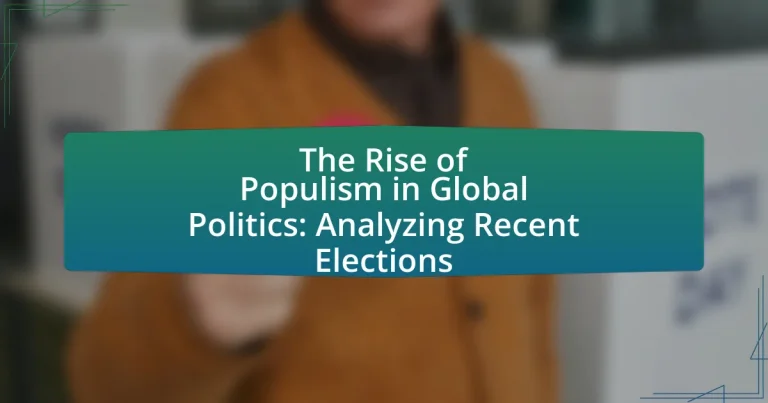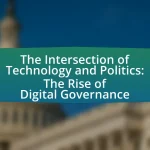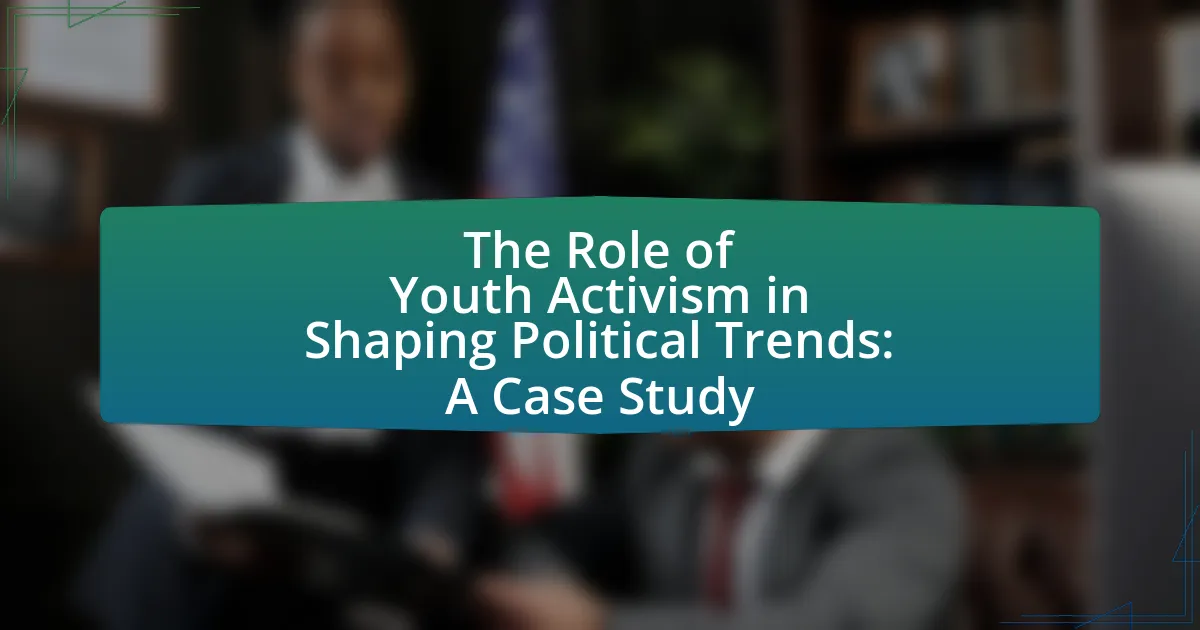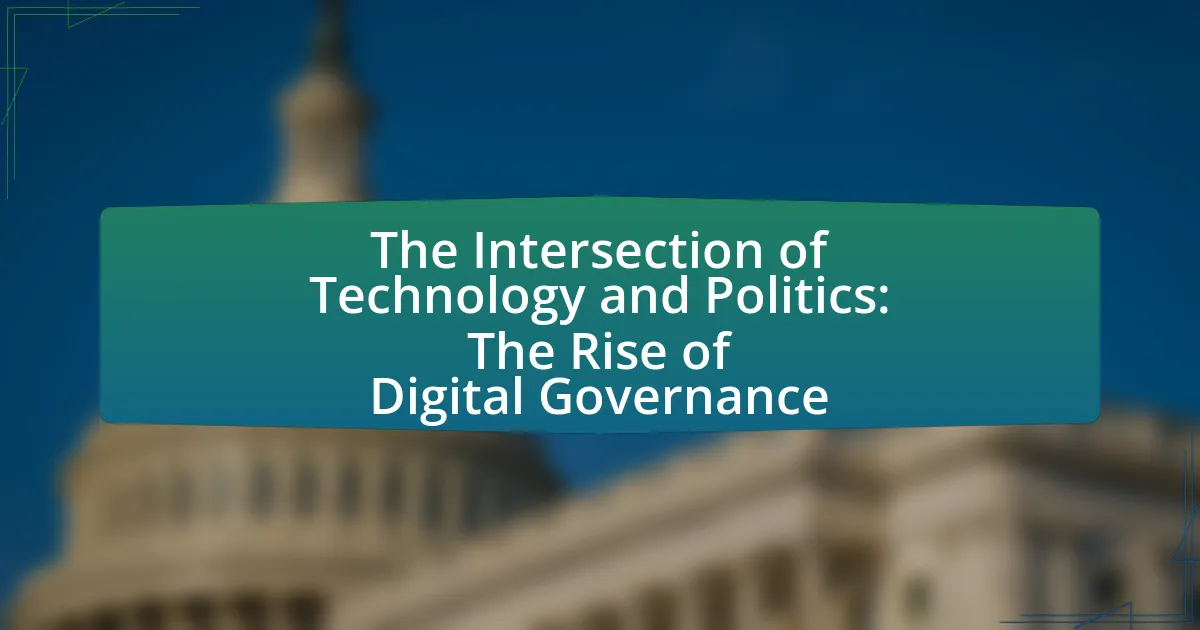The article examines the rise of populism in global politics, highlighting its increasing influence on political movements that claim to represent the “common people” against established elites. It discusses the evolution of populism, particularly through the use of social media, and identifies historical factors such as economic inequality and political corruption that have contributed to its growth. The article also analyzes the impact of populism on recent elections worldwide, detailing how populist candidates have outperformed traditional candidates and the implications for democratic institutions. Key characteristics of populist leaders, their communication strategies, and the policies they advocate are explored, alongside potential strategies for traditional parties and civil society to address the challenges posed by populism.

What is the Rise of Populism in Global Politics?
The rise of populism in global politics refers to the increasing influence of political movements that claim to represent the “common people” against the established elite. This phenomenon has been characterized by leaders and parties that utilize anti-establishment rhetoric, often appealing to national identity and economic grievances. For instance, the election of Donald Trump in the United States in 2016 and the Brexit referendum in the United Kingdom exemplify how populist movements have gained traction by capitalizing on public discontent with traditional political institutions. According to a 2020 study by the Pew Research Center, many countries have seen a significant increase in support for populist parties, reflecting a broader trend of dissatisfaction with globalization and economic inequality.
How has populism evolved in recent years?
Populism has evolved in recent years by increasingly leveraging social media and digital platforms to mobilize support and disseminate messages. This shift has allowed populist leaders to bypass traditional media channels, directly engaging with their audiences and shaping narratives that resonate with public sentiments. For instance, the rise of figures like Donald Trump in the United States and Jair Bolsonaro in Brazil exemplifies how populism has adapted to contemporary communication methods, utilizing platforms like Twitter and Facebook to amplify their messages. Additionally, recent elections in various countries have shown a trend towards populist parties gaining traction by addressing economic inequality and anti-establishment sentiments, as seen in the successes of parties like the Five Star Movement in Italy and the National Rally in France. These developments indicate a significant transformation in the strategies and appeal of populism in the global political landscape.
What historical factors contributed to the rise of populism?
The rise of populism has been significantly influenced by historical factors such as economic inequality, political corruption, and social discontent. Economic inequality, particularly during periods of financial crises, has led to widespread dissatisfaction with traditional political elites, prompting populist movements to gain traction by promising to represent the “common people.” For instance, the 2008 financial crisis exacerbated wealth disparities, leading to the emergence of populist leaders who capitalized on public anger towards established institutions. Political corruption has also fueled populism, as scandals and perceived failures of governance have eroded trust in traditional parties, making populist rhetoric appealing. Additionally, social discontent stemming from issues like immigration and cultural changes has mobilized support for populist agendas, as seen in various elections across Europe and the Americas. These historical factors collectively create an environment conducive to the rise of populism, as they resonate with the frustrations and aspirations of the electorate.
How do economic conditions influence populist movements?
Economic conditions significantly influence populist movements by creating environments of discontent and perceived neglect among the populace. When economic downturns occur, such as recessions or high unemployment rates, individuals often feel marginalized and dissatisfied with traditional political parties, leading them to seek alternative solutions. For instance, during the 2008 financial crisis, many countries experienced a surge in populist sentiments as economic instability prompted voters to support leaders who promised radical change and direct representation of the people’s interests. This trend is supported by research from the Pew Research Center, which found that economic anxiety correlates with increased support for populist parties across various nations.
Why is populism gaining traction in various countries?
Populism is gaining traction in various countries due to widespread dissatisfaction with traditional political elites and institutions. This discontent is often fueled by economic inequality, cultural anxieties, and a perceived disconnect between the government and the populace. For instance, the 2008 financial crisis led to significant economic hardship for many, prompting a rise in populist movements that promise to represent the “common people” against the elite. Additionally, the increasing influence of social media has allowed populist leaders to communicate directly with their supporters, bypassing traditional media channels that are often viewed with skepticism. This combination of economic distress and effective communication strategies has contributed to the growing appeal of populism globally.
What role does social media play in the spread of populist ideas?
Social media significantly amplifies the spread of populist ideas by providing a platform for direct communication between populist leaders and their supporters. This medium allows for rapid dissemination of messages that resonate with public sentiments, often bypassing traditional media filters. For instance, during the 2016 U.S. presidential election, Donald Trump’s campaign effectively utilized Twitter to engage with voters, resulting in a substantial increase in his visibility and support. Research by the Pew Research Center indicates that social media platforms are crucial for political engagement, with 62% of adults in the U.S. stating they get news from social media, which facilitates the viral spread of populist rhetoric.
How do cultural and identity issues fuel populist sentiments?
Cultural and identity issues fuel populist sentiments by creating a sense of division between “us” and “them,” often based on perceived threats to national identity or cultural values. Populist leaders exploit these sentiments by framing themselves as defenders of the common people against elites or outsiders, which resonates with individuals feeling marginalized or threatened by globalization, immigration, or cultural change. For instance, in the 2016 U.S. presidential election, Donald Trump capitalized on fears surrounding immigration and cultural shifts, appealing to voters who felt their identity was under siege, which contributed to his electoral success. This dynamic illustrates how cultural and identity concerns can mobilize support for populist movements, as they tap into deep-seated emotions and societal anxieties.

What are the key characteristics of populist leaders?
Populist leaders are characterized by their appeal to the common people, often positioning themselves against the elite or establishment. They typically employ a rhetoric that emphasizes a direct connection with the populace, claiming to represent the “true voice” of the people. This is often accompanied by a simplistic narrative that divides society into two groups: the virtuous common people and the corrupt elite.
Additionally, populist leaders frequently utilize charismatic communication styles, leveraging social media to bypass traditional media channels and engage directly with supporters. They may also adopt nationalist or anti-globalization stances, advocating for policies that prioritize the interests of their nation over international considerations. Historical examples include leaders like Hugo Chávez in Venezuela and Donald Trump in the United States, both of whom mobilized significant support through these characteristics.
How do populist leaders communicate with their supporters?
Populist leaders communicate with their supporters primarily through direct and emotional messaging that emphasizes a connection with the “common people.” They often utilize social media platforms to bypass traditional media, allowing for unfiltered communication and immediate engagement. For instance, leaders like Donald Trump and Jair Bolsonaro have effectively used Twitter and Facebook to share their views, rally support, and respond to critics in real-time, fostering a sense of community among their followers. This approach is supported by research indicating that populist rhetoric often includes simplistic language and appeals to national identity, which resonate strongly with their base, as seen in studies analyzing the communication strategies of populist movements across various countries.
What rhetorical strategies do they employ?
Populist leaders employ rhetorical strategies such as emotional appeals, simplification of complex issues, and the use of inclusive language. Emotional appeals resonate with the audience’s feelings, often invoking fear or hope to mobilize support. Simplification of complex issues allows these leaders to present their messages in a way that is easily digestible, often framing problems in binary terms of “us versus them.” Inclusive language fosters a sense of belonging among supporters, creating a collective identity that strengthens their base. These strategies are evident in recent elections, where populist candidates have successfully connected with voters by addressing their concerns and frustrations directly.
How do populist leaders portray their opponents?
Populist leaders typically portray their opponents as elite, out-of-touch individuals who prioritize their own interests over the needs of the common people. This characterization often includes labeling opponents as corrupt, ineffective, or part of a political establishment that is disconnected from the struggles of ordinary citizens. For instance, during the 2016 U.S. presidential election, Donald Trump frequently referred to his opponent, Hillary Clinton, as part of a “rigged system,” suggesting that she represented the political elite rather than the average American. This strategy aims to create a clear dichotomy between the populist leader and their opponents, reinforcing the populist narrative of being a voice for the marginalized and disenfranchised.
What policies do populist movements typically advocate for?
Populist movements typically advocate for policies that prioritize the interests of the “common people” over the elite. These policies often include economic nationalism, which emphasizes protectionist trade measures to safeguard domestic industries, and anti-immigration stances aimed at reducing immigration levels to protect jobs and cultural identity. Additionally, populist movements frequently promote direct democracy initiatives, such as referendums, to empower citizens and bypass traditional political institutions. Evidence of these trends can be seen in the rise of leaders like Donald Trump in the United States, who implemented tariffs on imports and adopted strict immigration policies, and in the Brexit campaign in the United Kingdom, which focused on reclaiming sovereignty from the European Union.
How do these policies differ from traditional political platforms?
Populist policies differ from traditional political platforms primarily in their focus on direct appeal to the general populace, often bypassing established political institutions and elites. Traditional platforms typically emphasize party ideology, structured policy proposals, and compromise, while populist policies prioritize emotional resonance, anti-establishment rhetoric, and a simplified narrative that positions the “common people” against a perceived corrupt elite. For instance, populist movements in recent elections, such as those led by figures like Donald Trump in the United States and Jair Bolsonaro in Brazil, have utilized social media to directly engage with voters, fostering a sense of immediacy and personal connection that contrasts with the more formal communication styles of traditional political parties. This shift reflects a broader trend where populism capitalizes on public discontent and seeks to mobilize support through charismatic leadership and a rejection of conventional political norms.
What are the implications of these policies on governance?
The implications of populist policies on governance include increased polarization and challenges to traditional political institutions. Populist policies often prioritize the will of the majority, which can undermine checks and balances, leading to authoritarian tendencies. For instance, in Hungary, Prime Minister Viktor Orbán’s government has enacted policies that centralize power and weaken judicial independence, demonstrating how populism can alter governance structures. Additionally, populist rhetoric frequently targets elites and institutions, fostering distrust and potentially destabilizing democratic norms, as seen in the United States during the Trump administration, where attacks on the media and judiciary were prevalent. These examples illustrate that populist policies can significantly reshape governance by prioritizing populist agendas over established democratic frameworks.
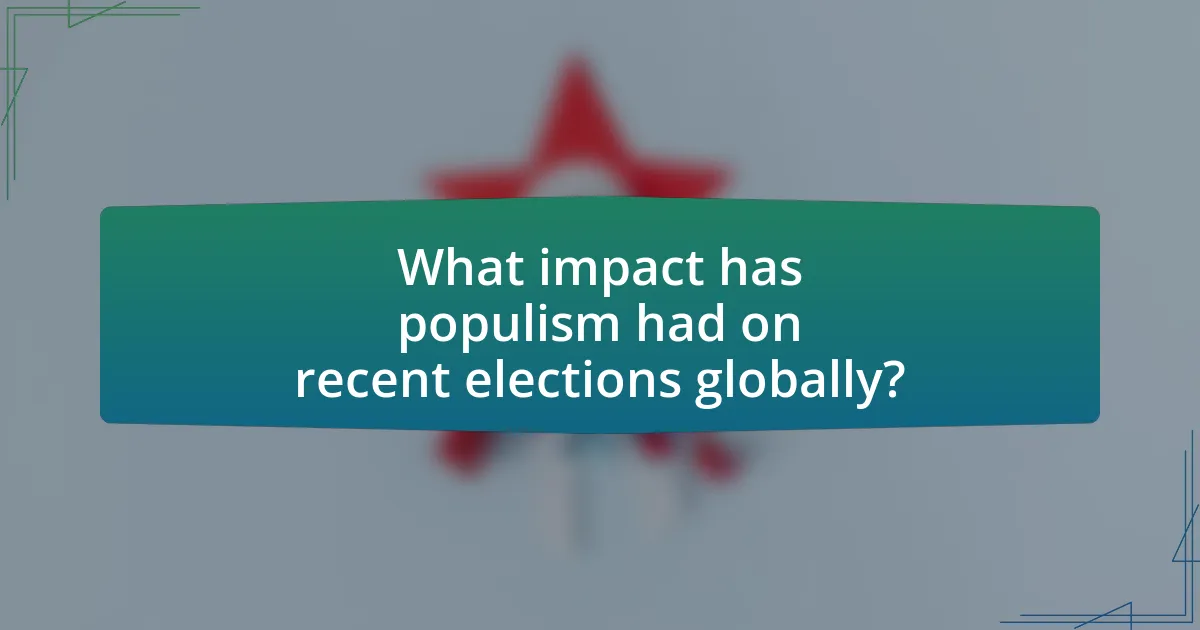
What impact has populism had on recent elections globally?
Populism has significantly influenced recent elections globally by reshaping political landscapes and voter behavior. In countries like the United States, the election of Donald Trump in 2016 exemplified how populist rhetoric can mobilize disenchanted voters, leading to a departure from traditional party politics. Similarly, in Brazil, Jair Bolsonaro’s rise to power in 2018 showcased the effectiveness of populist strategies in appealing to anti-establishment sentiments. Furthermore, the rise of populist parties in Europe, such as Italy’s League and France’s National Rally, has disrupted established political alliances, resulting in increased polarization and challenges to mainstream parties. These trends indicate that populism has not only altered electoral outcomes but also transformed the dynamics of political discourse worldwide.
Which recent elections have been significantly influenced by populism?
Recent elections significantly influenced by populism include the 2016 United States presidential election, the 2017 French presidential election, and the 2018 Brazilian presidential election. In the United States, Donald Trump’s campaign capitalized on anti-establishment sentiments and economic discontent, leading to his victory. In France, Marine Le Pen’s National Front gained substantial support by promoting nationalist and anti-immigration rhetoric, ultimately reaching the runoff against Emmanuel Macron. In Brazil, Jair Bolsonaro’s populist approach, focusing on law and order and anti-corruption, resonated with voters, resulting in his election. These elections exemplify how populism has reshaped political landscapes in various countries.
What were the outcomes of these elections?
The outcomes of these elections indicated a significant rise in populist parties across various countries. For instance, in the 2022 Brazilian presidential election, Luiz Inácio Lula da Silva, representing a leftist populist agenda, defeated the incumbent Jair Bolsonaro, reflecting a shift in voter sentiment towards populism. Similarly, in Hungary, Viktor Orbán’s Fidesz party secured a fourth consecutive term, showcasing the resilience of right-wing populism in Europe. These results demonstrate a broader trend where voters are increasingly favoring populist candidates who promise to address economic inequality and national sovereignty, as evidenced by the electoral successes in both Latin America and Europe.
How did populist candidates perform compared to traditional candidates?
Populist candidates generally outperformed traditional candidates in recent elections, reflecting a significant shift in voter sentiment. For instance, in the 2016 U.S. presidential election, Donald Trump, a populist candidate, won the presidency against traditional candidate Hillary Clinton, securing 304 electoral votes compared to Clinton’s 227. Similarly, in the 2018 Brazilian presidential election, Jair Bolsonaro, a populist, won with 55.13% of the vote against Fernando Haddad, a traditional candidate. These examples illustrate that populist candidates have gained traction by appealing directly to voter frustrations with the political establishment, often resulting in electoral success over their traditional counterparts.
What are the consequences of populism for democratic institutions?
Populism undermines democratic institutions by eroding checks and balances, fostering polarization, and diminishing public trust in governance. Populist leaders often concentrate power, bypassing traditional democratic processes, which can lead to authoritarianism. For instance, in Hungary, Viktor Orbán’s government has systematically weakened judicial independence and curtailed media freedoms, demonstrating how populism can dismantle democratic norms. Additionally, populism tends to create a divisive political climate, as seen in the United States during the Trump administration, where partisan divides intensified, impacting legislative effectiveness and civic discourse. These consequences illustrate the significant threats populism poses to the integrity and functionality of democratic institutions.
How does populism challenge established political norms?
Populism challenges established political norms by promoting a dichotomy between the “elite” and the “common people,” often undermining traditional political institutions and practices. This movement typically rejects established political parties and their platforms, advocating for direct representation of the people’s will, which can lead to the erosion of democratic norms. For instance, leaders like Donald Trump in the United States and Jair Bolsonaro in Brazil have utilized populist rhetoric to delegitimize mainstream media and political opposition, framing them as corrupt or out of touch with the populace. This approach can destabilize political discourse and diminish the role of checks and balances, as seen in various populist movements worldwide that have sought to concentrate power in the hands of a single leader or party.
What risks does populism pose to democratic governance?
Populism poses significant risks to democratic governance by undermining institutional checks and balances. This occurs as populist leaders often concentrate power, eroding the independence of the judiciary and media, which are essential for a functioning democracy. For instance, in Hungary, Prime Minister Viktor Orbán has implemented policies that weaken judicial oversight and restrict press freedoms, leading to a decline in democratic norms. Additionally, populism can foster polarization and social division, as populist rhetoric often pits “the people” against perceived elites, creating an environment where compromise becomes difficult. This was evident in the United States during the Trump administration, where divisive language contributed to increased political hostility. Overall, the rise of populism can destabilize democratic institutions and societal cohesion, threatening the very foundations of democratic governance.
What strategies can be employed to address the rise of populism?
To address the rise of populism, governments and political parties can implement inclusive economic policies that reduce inequality and enhance social welfare. Research indicates that economic disparities often fuel populist sentiments, as seen in various elections where candidates capitalized on discontent related to job loss and wage stagnation. For instance, the 2016 U.S. presidential election highlighted how economic grievances in the Rust Belt contributed to the rise of populist rhetoric. Additionally, fostering open dialogue and engagement with diverse communities can counteract the divisive narratives often propagated by populist leaders. Studies show that when citizens feel heard and represented, they are less likely to support extreme populist movements.
How can traditional parties adapt to the populist challenge?
Traditional parties can adapt to the populist challenge by embracing a more inclusive and responsive political platform that addresses the concerns of disenchanted voters. This adaptation involves actively engaging with grassroots movements, prioritizing transparency, and reforming policies to reflect the needs of the electorate, particularly on issues like economic inequality and immigration. Evidence of this approach can be seen in the strategies employed by parties in various countries, such as the Labour Party in the UK, which shifted its focus to social justice and workers’ rights to regain support from traditional bases that felt neglected. By aligning their messaging with the values and priorities of the populace, traditional parties can effectively counter the appeal of populist movements.
What role can civil society play in countering populist narratives?
Civil society can play a crucial role in countering populist narratives by promoting democratic values, fostering critical thinking, and facilitating dialogue among diverse groups. Organizations within civil society, such as NGOs and community groups, can educate citizens about the dangers of populism, which often relies on misinformation and divisive rhetoric. For instance, initiatives that encourage media literacy help individuals discern credible information from populist propaganda, thereby reducing the effectiveness of misleading narratives. Additionally, civil society can mobilize grassroots movements that advocate for inclusive policies, countering the exclusionary tactics often employed by populist leaders. Research indicates that countries with strong civil society engagement tend to have more resilient democracies, as seen in the cases of various European nations where civic activism has successfully challenged populist trends.
